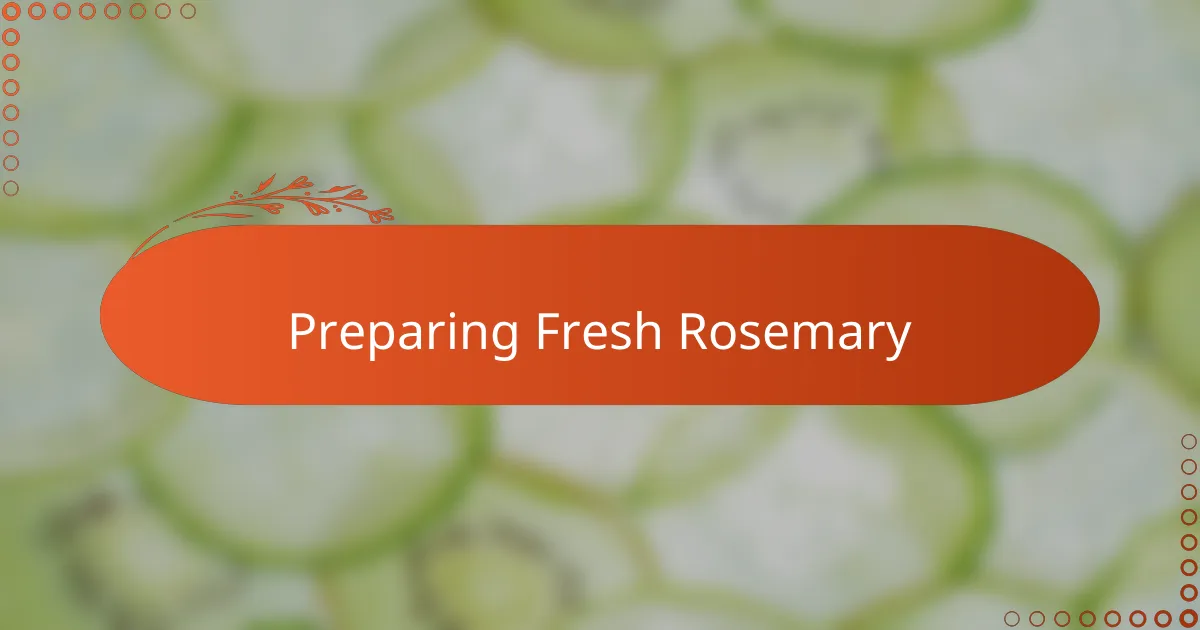Key takeaways
- Herbal infusions, like rosemary, are simple to make and focus on extracting the essence of herbs through steeping in hot water.
- Rosemary infusions offer mental clarity and carry antioxidants, supporting overall health while connecting one to traditional practices.
- Using fresh rosemary and filtered water enhances the flavor, and light bruising of the leaves unlocks deeper aromas.
- Experimenting with steeping time and adding extras like lemon peel or cinnamon can enhance the infusion’s flavor profile significantly.

Understanding Herbal Infusions
When I first started making herbal infusions, I was surprised by how simple the process actually is. Essentially, an herbal infusion involves steeping herbs, like rosemary, in hot water to extract their flavors and beneficial properties. It’s like brewing a tea, but with a focus on capturing the essence of fresh or dried herbs at their best.
Have you ever wondered why certain herbs release their aromas so beautifully in hot water? For me, it’s the gentle coaxing of heat that draws out the oils and nutrients, creating a rich, fragrant drink. It’s almost like the herbs are telling a story, if you listen closely as they steep.
Understanding this process helped me appreciate herbal infusions not just as beverages, but as a way to connect with nature’s healing gifts. Each infusion feels like a small ritual—a moment of calm and mindfulness—that I cherish in my busy homesteading days.

Benefits of Rosemary Infusions
I’ve found that rosemary infusions do more than just taste wonderful—they have a subtle way of clearing the mind. Whenever I sip on a warm cup, it feels like my focus sharpens, almost like the rosemary is giving my brain a gentle nudge. Have you ever noticed how certain aromas can instantly lift your spirits? Rosemary does just that, bringing a sense of clarity and calm that’s hard to beat.
Beyond the mental boost, I appreciate how rosemary infusions carry natural antioxidants. This means each cup helps support my immune system, which is a real bonus when working outdoors on the homestead. Knowing that my simple ritual has these hidden health benefits makes the experience feel even more rewarding.
Sometimes, I think about how these infusions connect me to traditions that go way back in time. People have trusted rosemary for its healing properties for centuries, and brewing my own infusion feels like stepping into an age-old practice. It’s a beautiful reminder that nature has been providing remedies long before modern medicine, and I’m grateful to tap into that wisdom.

Essential Ingredients and Tools
When I gather my ingredients for a rosemary infusion, fresh rosemary is always my go-to. There’s something about the vibrant green sprigs—plucked right from my garden—that makes the infusion feel more alive. Of course, dried rosemary works well too, especially when fresh isn’t in season, but nothing quite matches the aroma of fresh herbs.
A good-quality, clean water source is essential, and I always make sure to use filtered water. It’s amazing how much the purity of water influences the final taste. Have you ever noticed how tap water can sometimes dull the delicate flavors? Using the right water makes all the difference.
For tools, I rely on a simple glass teapot or a heatproof jar—nothing fancy, but practical. I’ve also found that a fine mesh strainer really helps capture those tiny needle-like leaves to keep the infusion smooth. Over time, these small tools have become trusty companions in my herbal ritual, making the process both easy and enjoyable.

Preparing Fresh Rosemary
Preparing fresh rosemary is a step I never rush because the quality of the herb sets the tone for the entire infusion. I usually pick sprigs from my garden early in the morning when the leaves are crisp and full of essential oils. Have you ever noticed how just snapping a fresh rosemary twig releases that powerful, pine-like aroma? It’s that scent that promises richness in every cup.
Once I bring the rosemary inside, I give the sprigs a gentle rinse under cool water to remove any dust or tiny insects. It might seem like a small detail, but I’ve learned that skipping this step can affect the clarity and taste of the infusion. Drying the rosemary by patting it softly with a towel helps prevent unwanted water from diluting the flavor when steeping.
Sometimes, I like to lightly bruise the leaves by crushing them between my fingers before adding them to hot water. This little trick always amazes me—it unlocks even deeper flavors and oils that transform a simple herb into something vibrant and soothing. Have you tried this method? If not, I promise it’s worth experiencing.

Step by Step Infusion Process
First, I bring fresh rosemary sprigs or dried leaves into a heatproof container, like my trusty glass teapot. I pour boiled water—just off the boil—to gently cover the herbs, then cover the container to trap all those precious oils and aromas. Have you ever noticed how the steam rising feels like a little invitation to pause and breathe deeply? That moment always makes me slow down and appreciate the process.
Next, I let the rosemary steep for about 10 to 15 minutes, though sometimes I stretch it longer when I want a stronger flavor. The longer it sits, the more robust and fragrant the infusion becomes, almost like the herbs are releasing their stories into the water. I sometimes peek in and catch the swelling green leaves, reminding me of fresh morning dew—simple beauty in a cup.
Finally, I strain out the rosemary leaves using a fine mesh strainer to keep the infusion silky smooth. Pouring that amber liquid into my favorite mug always feels like a small victory, a reward for taking the time to make something pure and nourishing. Have you ever experienced how such a humble ritual can create a comforting pause in a busy day? That’s the magic I seek every time I brew.

Tips for Flavor Enhancement
One tip I’ve found invaluable is to experiment with the steeping time. Sometimes, a shorter steep yields a lighter, more refreshing taste, perfect for hot days. When I want something richer, I let the infusion sit longer, and it never fails to deepen the rosemary’s earthy notes—have you noticed how timing can completely change the mood of your cup?
Another trick I swear by is adding a tiny pinch of lemon peel or a cinnamon stick while steeping. These little touches brighten or warm the infusion subtly without overpowering the rosemary. It feels like giving the infusion a gentle nudge toward a whole new level of flavor, and I love discovering those small flavor companions in my kitchen.
I also pay close attention to the water temperature—too hot can scorched the herbs, leaving a bitter edge, while too cool won’t coax out enough oils. Using water just off the boil has been my sweet spot; it feels like the perfect balance to unlock rosemary’s essence gently. Don’t you find it fascinating how a few degrees can make such a difference in taste?



